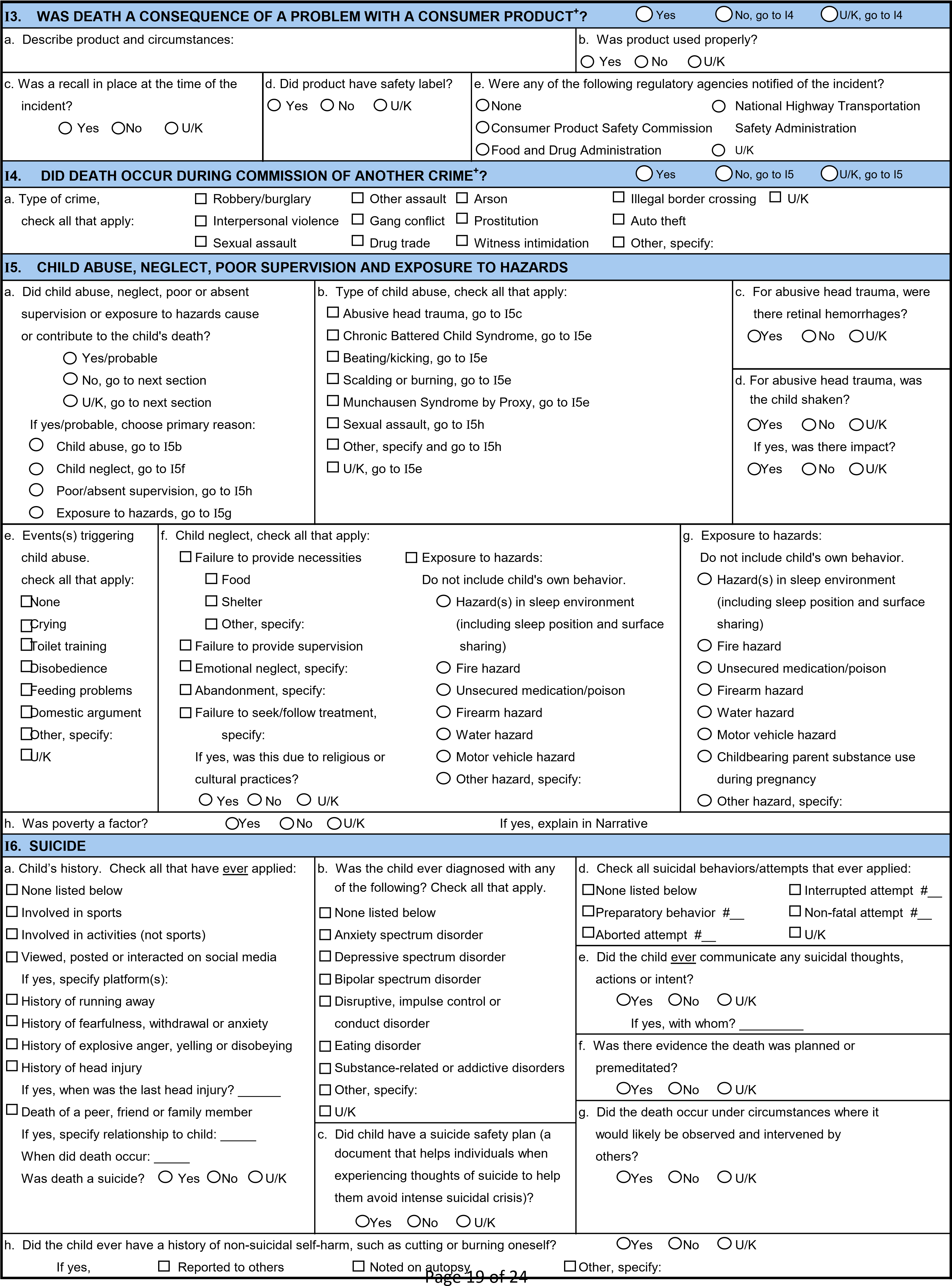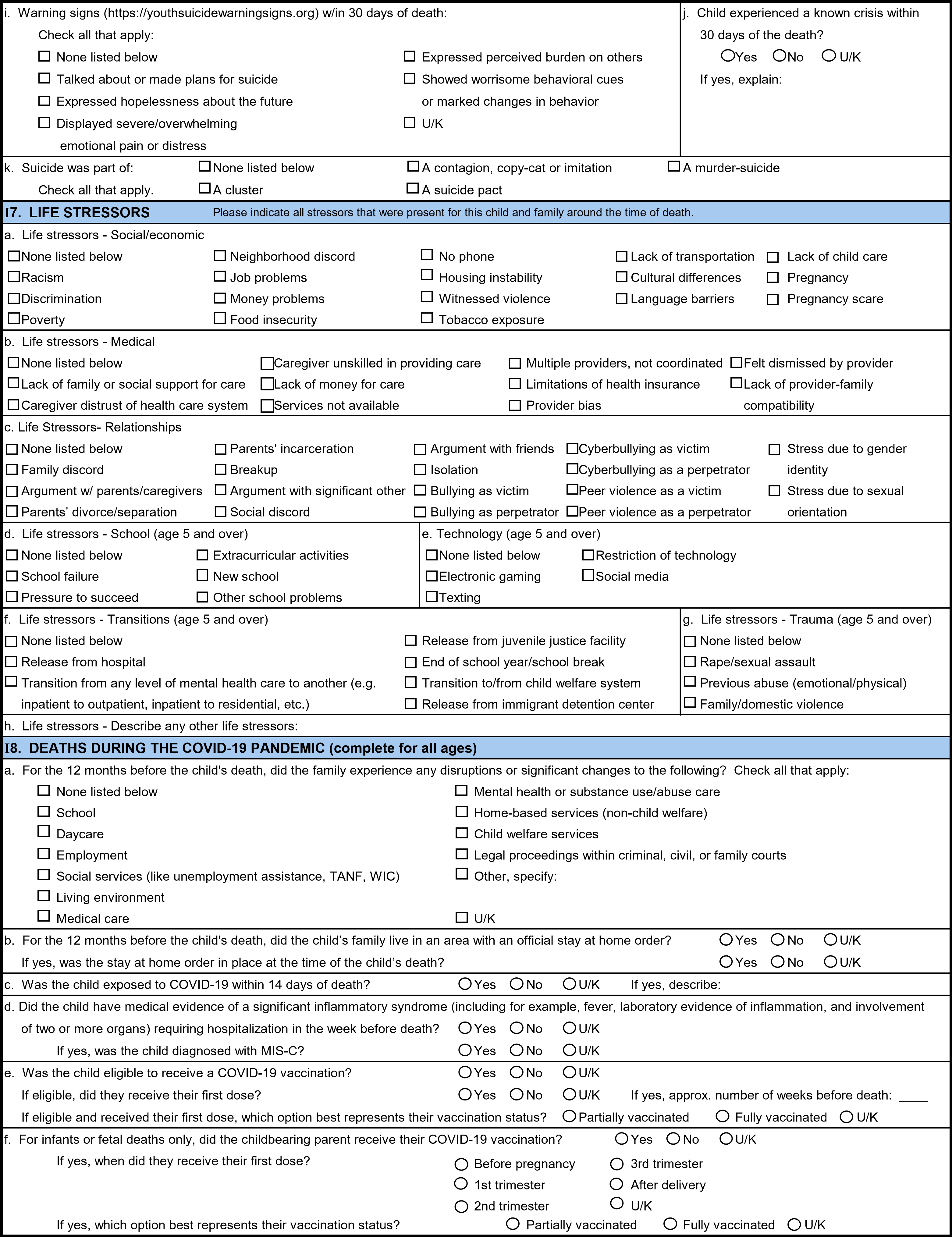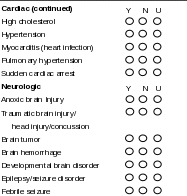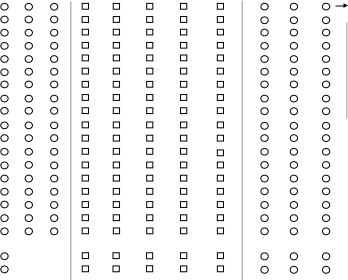0920-1092 Att 2a_NFR-CRS-SDY Module I
[NCCDPHP]Sudden Death in the Young Registry
Att 2a_NFR-CRS-SDY Module I
SDY Module - State Health Personnel
OMB: 0920-1092
I. OTHER CIRCUMSTANCES OF INCIDENT - ANSWER RELEVANT SECTIONS |
||
I1. SUDDEN AND UNEXPECTED DEATH IN THE YOUNG (SDY) This section displays online based on your state's settings. |
||
Section I1: OMB No. 0920-1092, Exp. Date: 9/30/2025 Public reporting burden of this collection of information is estimated to average 10 minutes per response, including the time for reviewing instructions, searching existing data sources, gathering and maintaining the data needed, and completing and reviewing the collection of information. An agency may not conduct or sponsor, and a person is not required to respond to a collection of information unless it displays a currently valid OMB control number. Send comments regarding this burden estimate or any other aspect of this collection of information, including suggestions for reducing this burden to: CDC/ATSDR Reports Clearance Officer; 1600 Clifton Road NE, MS D-74, Atlanta, Georgia 30333; ATTN: PRA (0920-1092) |
||


a. Was this death:A homicide? A suicide? An overdose?If any of these apply, go to Section I2, A result of an external cause that was the obvious and only reason for the fatal injury?THIS IS NOT AN SDY CASE. Expected within 6 months due to terminal illness? None of the above, go to I1b THIS IS AN SDY CASE U/K, go to I1b |
||
b. Did the child have a history of any of the following acute conditions |
c. At any time more than 72 hours preceding death did the child have a personal |
|
or symptoms within 72 hours prior to death? |
history of any of the following chronic conditions or symptoms? |
|
Symptom Present w/in 72 hours of death |
Symptom Present more than 72 hours of death |
|
Cardiac Yes No U/K |
Cardiac |
Yes No U/K |
Chest
pain |
Chest pain |
|
Dizziness/lightheadedness |
Dizziness/lightheadedness |
|
Fainting |
Fainting |
|
Palpitations |
Palpitations |
|
Neurologic |
Neurologic |
|
Concussion |
Concussion |
|
Confusion |
Confusion |
|
Convulsions/seizure |
Convulsions/seizure |
|
Headache |
Head injury |
|
Head
injury |
Respiratory |
|
Respiratory |
Difficulty breathing |
|
Asthma |
Other |
|

Pneumonia Difficulty breathing Other Acute Symptoms |
Other,
specify: |
|
d. Did the child have any prior serious injuries (e.g. near drowning, car |
||
Fever |
accident, brain injury)? |
|
Muscle
aches/cramping |
|
|

Vomiting Other, specify: |
If yes, describe: |
|
e. Had the child in the past ever been diagnosed by a medical professional for the following? Condition Diagnosed Condition Diagnosed Condition Diagnosed |
||
Sickle cell disease Neurodegenerative disease Sickle cell traitStroke/mini stroke/ Thrombophilia (clotting disorder) TIA-Transient Ischemic Cardiac Y N UAttack
Abnormal
electrocardiogram Central nervous system (EKG or ECG)infection (meningitis Aneurysm or aortic dilatation or encephalitis) Arrhythmia/arrhythmia syndrome Respiratory Y N U Cardiomyopathy Apnea Congenital heart disease Asthma Coronary artery abnormalityPulmonary embolism EndocarditisPulmonary hemorrhage Heart failureRespiratory arrest Heart murmur |
||
Page 15 of 24
|
|||
f. Did the child have any blood relatives (brothers, sisters, parents, aunts, uncles, cousins, grandparents or other more distant |
g. Has any blood relative (siblings, |
||
relatives) with the following diseases, conditions or symptoms? |
parents, aunts, uncles, cousins, |
||
Y N U Deaths |
grandparents) had genetic |
||
|
testing? |
||
If yes, the type of event, which relative, and relative’s age at death (for example, brother at age 30 who died |


Yes No U/K |
||
in an unexplained motor vehicle accident (driver of car)): Heart Disease Y N U Symptoms |
If yes, describe the test/gene |
||
|
tested, reason for testing, family |
||
If
yes, describe: |
member tested, and results: |
||
Arrhythmia (fast or irregular heart rhythm) Congenital deafness Cardiomyopathy Connective tissue disease Congenital heart diseaseMitochondrial disease Neurologic DiseaseMuscle disorder or muscular dystrophy |
Was a gene mutation found? |
||


Epilepsy or convulsions/seizureThrombophilia (clotting disorder) Other neurologic diseaseOther diseases that are genetic or run in families, specify: |


Yes No U/K |
||
h. In the 72 hours prior to death was the child taking any prescribed |
k. Was the child taking any of the following substance(s) within 24 hours of death? |
||
|
Check all that apply: |
||
If yes, describe: |
|


Over-the-counter medicineAlcohol Energy drinksIllegal drugs |
|
i. Within 2 weeks prior to death had the child: |
N/A Yes No U/K |
||
Taken extra doses of prescribed medications |
|
|
|
Missed doses of prescribed medications |
|
|
|
Changed prescribed medications, describe: |
|

Supplements Tobacco
|
|
j. Was the child compliant with their prescribed medications? |
|||
If not compliant, describe why and how often: |
If yes to any items above, describe: |
||
l. Did the child experience any of the following stimuli at time of incident or within 24 hours of the incident? At incident Within 24 hrs of incident
Physical activityIf yes to physical activity, describe type of activity: Sleep deprivationAt incident Within 24 hours of incident Driving Visual/video game stimuli Emotional stimuli Auditory stimuli/startle Physical traumaOther specify: Other, specify:At incident Within 24 hours of incident |
|||
If
yes, type of sport: Competitive
|
|||||||
n. Did the child ever have any of the following uncharacteristic symptoms |
o. For child age 12 or older, did the child receive a pre-participation exam |
||||||
during or within 24 hours after physical activity? Check all that apply: |
|
||||||
|
If yes: |
||||||
|
Was
it done within a year prior to death? |
||||||
|
Did the exam lead to restrictions for sports or otherwise? |
||||||
|
|
||||||
If yes to any item, describe type of physical activity and extent of symptoms: |
If yes, specify restrictions: |
||||||
Questions p through v: Answer if "Epilepsy/Seizure Disorder" is answered Yes in question e above (Diagnosed for a medical condition) |
|||||||
p. How old was the child when diagnosed with epilepsy/seizure disorder?
Age
0 (infant) through 20 years:
|
r. What type(s) of seizures did the child have? Check all that apply: 
Non-convulsive Convulsive (grand mal seizure or generalized tonic-clonic seizure) Occur when exposure to strobe lights, video game, or flickering light (reflex seizure) U/K |
t. How many seizures did the child have in the year preceding death? 


0/never 2More than 3 13U/K |
|||||
q. What were the underlying cause(s) of the child’s seizures? Check all that apply:
specify: injury other than Brain tumor epilepsy CerebrovascularOther, specify: Central nervous system infection U/K Developmental brain disorder Genetic/chromosomal Idiopathic or cryptogenic |
u. Did treatment for seizures includ anti-epileptic drugs?
If yes, how many different types of antiepileptic drugs did the child 


14 25 36 |
e take? More than 6 U/K |
|||||
s. Describe the child's epilepsy/seizures (not including the seizure at time of death). Check all that apply: 
Last less than 30 minutes Last more than 30 minutes (status epilepticus) Occur in the presence of fever (febrile seizure) Occur in the absence of fever Occur when exposed to strobe lights, video game, or flickering light (reflex seizure) |
|||||||
v. Was night surveillance used? 

|
|||||||
I2. ANSWER THIS ONLY IF CHILD IS UNDER AGE FIVE: 


Yes, go to I2a No, go to I2tU/K, go to I2a WAS DEATH RELATED TO SLEEPING OR THE SLEEP ENVIRONMENT+? |
|||||||
a. Incident sleep place:
PortableCouchSwingQueen Unknown crib typeChairBouncy chairKing BassinetFloorOther, specify:Other, specify: Bed side sleeperCar seatU/KU/K Baby box |
|||||||

b. Child put to sleep: On back On stomach On side U/K |
c. Child found: 
On back On stomach On side U/K |

e. Usual sleep position: On back On stomach On side U/K |
f. Was there any type of crib, portable crib or bassinet in home for child?
|
||||
d. Usual sleep place: 




Adult bedRocking-inclinedIf adult bed, what type? If crib, type:WaterbedsleeperTwinKing Not portableFutonStrollerFullOther, specify: PortableCouchSwingQueenU/K Unknown crib typeChairBouncy chair BassinetFloorOther, specify: 
Bed side sleeperCar seatU/K Baby box |
|||||||
g. Child in a new or different environment than usual?
If yes, describe why: |
h. Child last placed to sleep with a pacifier?
|
i. Child wrapped or swaddled in blanket when last placed?
If yes, describe: |
|||||
Page 17 of 24
|
k. Child exposed to second hand smoke? |
|||
Check
all that apply: |
|
|||
|
If yes, how often: |
|||
|
|
|||
l. Child's face when found: 
Down Up To left or right side U/K |
m. Child's neck when found: 
Hyperextended (head back) Hypoextended (chin to chest) Neutral Turned U/K |




n. Child's airway when found (includesIf fully or partially obstructed, what was obstructed? nose, mouth, neck and/or chest):NoseChest compressed Unobstructed by person or objectMouthU/K Fully obstructed by person or objectNeck compressed Partially obstructed by person orIf fully or partially obstructed, describe obstruction in objectdetail: U/K |
||
o. Objects in child's sleep environment and relation to airway obstruction: If present, describe position of object: If present, did object Objects: Present? On top Under Next Tangled obstruct airway? Yes No U/K of child child to child around child U/K Yes No UK
Other child(ren)airway, describe relation- Animal(s)ship of adult to child (for Mattressexample, childbearing Comforter, quilt, or otherparent): Fitted sheet Thin blanket/flat sheet Pillow(s) Cushion Nursing or U shaped pillow Sleep positioner (wedge) Bumper pads Clothing Bottle Wearable monitor Crib railing/side Wall Toy(s) Other(s), specify: __________________ __________________ |
||||
p.
Was there a reliable, non-conflicting witness account of how the
child was found? |
||||
q. Caregiver/supervisor fell asleep while feeding child?
|
r. Child sleeping in the same room as caregiver/supervisor at time of death? |
|||



s. Child sleeping on same If yes, reasons stated for sleeping on If yes, check all that apply: surface with person(s) or same surface, check all that apply:With adult(s): # _______ animal(s)?To feedAdult obese: U/K
Usual sleep patternWith animal(s): # _______ Type(s) of animal: ________ No infant bed availableU/K Home/living space overcrowded Other, specify: U/K |
||||
t.
Is there a scene re-creation photo available for upload? Select photo that demonstrates position and location of child’s body and airway (nose, mouth, neck, and chest). Size must be less than 6 mb and in .jpg or .gif format. |
||||


g. Select the one option that best describes the impact of COVID-19 on this child’s death: |
h. Did COVID-19 impact the team’s ability to conduct this fatality review? |
|||||||||
|
|
|||||||||
|
If yes, check all that apply: |
|||||||||
|
|
|||||||||
underlying cause of death |
|
|||||||||
|
|
|||||||||


Before pregnancy3rd trimester 1st trimesterAfter delivery 2nd trimesterU/K 
Other, specify: COVID-19 had no impact on this child's death U/K |
|
|||||||||
J. PERSON RESPONSIBLE (OTHER THAN DECEDENT) This section is skipped for fetal deaths+ |
||||||||||
1. Did a person or persons other than the |
2. What act(s)? Enter information for the first person under "One" and if |
3. Did the team have information |
||||||||
child do something or fail to do |
there is a second person, use column "Two." Describe acts in narrative. |
about the person(s)? |
||||||||
something that caused or contributed |
One Two One Two |
One Two |
||||||||
to the death? |
|
|
|
|||||||
|
|
|
|
|||||||
|
|
|
|
|||||||
|
supervision |
|
|
|||||||
4. Is person listed in a previous section? |
5. Primary person(s) responsible for action(s): Select one for each person respo |
nsible. |
||||||||
One Two |
One Two |
One Two |
One |
Two |
||||||
|
|
|
|
|
||||||
|
|
|
|
|
||||||
parent, go to J17 |
|
|
|
|
||||||
|
|
|
|
|
||||||
|
|
|
|
worker |
||||||
|
|
girlfriend |
|
|
||||||
|
|
|
|
|
||||||
6. Person's age in years: |
7. Person's sex: |
8. Person speaks and understands English? |
9. Person on active military duty? |
|||||||
One Two |
One Two |
One Two |
One Two |
|||||||
|
|
|
|
|||||||
|
|
|
|
|||||||
|
|
|
|
|||||||
|
|
If no, language spoken: |
If yes, specify branch: |
|||||||
10. Person(s) have history of |
11. Person(s) have history of child |
12. Person(s) have history of child |
13. Person(s) have disability or chronic |
|||||||
substance abuse? |
maltreatment as victim? |
maltreatment as a perpetrator? |
illness? |
|||||||
One Two |
One Two |
One Two |
One Two |
|||||||
|
|
|
|
|||||||
|
|
|
|
|||||||
|
|
|
|
|||||||
14. Person(s) have prior |
15. Person(s) have history of intimate partner violence? |
16. Person(s) have delinquent/criminal history? |
||||||||
child deaths? |
One Two |
One Two |
||||||||
One Two |
|
|
||||||||
|
|
|
||||||||
|
|
|
||||||||
|
|
|
||||||||
17. At the time of the incident, was the person asleep? One Two
Yes description of the person's sleeping Day time nap, describe: No period at incident:Day time sleep (for example, person is night shift worker), describe: U/KOther, describe: |
||||||||||
Page 21 of 24
| File Type | application/vnd.openxmlformats-officedocument.wordprocessingml.document |
| Author | installer |
| File Modified | 0000-00-00 |
| File Created | 2025-09-19 |
© 2025 OMB.report | Privacy Policy






 No
No 


 Blood
disease Y
N
UNeurologic
(continued) Y
N
U
Blood
disease Y
N
UNeurologic
(continued) Y
N
U
 Diabetes
Diabetes
 Sudden
unexpected death before age 50
Sudden
unexpected death before age 50 Heart
condition/heart attack or stroke before age 50
Heart
condition/heart attack or stroke before age 50
 Febrile
seizures
Febrile
seizures
 Unexplained
fainting
Unexplained
fainting
 Aortic
aneurysm or aortic rupture Other
Diagnoses
Aortic
aneurysm or aortic rupture Other
Diagnoses medication(s)?
medication(s)? 
 Caffeine
Caffeine  Legalized marijuana
Legalized marijuana Other, specify:
Other, specify:


 Stimuli
Yes
No
U/K
Yes
No
U/K
Stimuli
Yes
No
U/K
Yes
No
U/K
 m.
Was the child an athlete?
m.
Was the child an athlete?  Recreational
Recreational  Yes No U/K
Yes No U/K U/K
U/K Chest pain
Chest pain  Palpitations
Palpitations Convulsions/seizure
Convulsions/seizure  Yes
Yes 

 Brain
injury/trauma,
Brain
injury/trauma,  U/K
U/K


 Adult
bedRocking-inclinedIf adult bed, what type? If car seat, was car
seat
Adult
bedRocking-inclinedIf adult bed, what type? If car seat, was car
seat If
crib, type:WaterbedsleeperTwin secured in seat of car?
If
crib, type:WaterbedsleeperTwin secured in seat of car?
 Adult(s)If
adult(s) obstructed
Adult(s)If
adult(s) obstructed If
yes, type of feeding: Bottle
If
yes, type of feeding: Bottle  COVID-19
was the immediate or underlying cause of death
COVID-19
was the immediate or underlying cause of death Yes
Yes  Unable
to obtain records
Unable
to obtain records Remote
reviews negatively impacted review process
Remote
reviews negatively impacted review process Child
abuse
Child
abuse  Exposure
to hazards
Exposure
to hazards
 Other,
specify:
Other,
specify: U/K
U/K Yes,
childbearing parent, go to J17
Yes,
childbearing parent, go to J17 Adoptive
parent
Adoptive
parent Sibling
Sibling
 Yes,
non-childbearing biological
Yes,
non-childbearing biological Stepparent
Stepparent Foster
parent
Foster
parent Friend
Friend Male
Male
 Yes
Yes #
Years
#
Years Female
Female No
No No
No U/K
U/K U/K
U/K U/K
U/K Yes
Yes No
No U/K
U/K U/K
U/K Yes,
as victim
Yes,
as victim
 One Two If
yes, select the most appropriate Night time sleep
One Two If
yes, select the most appropriate Night time sleep